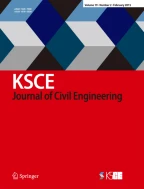Abstract
Lightweight Foamed Concrete (LFC) is one of the recent advancement of concrete technology in civil engineering. Different gradation of sand in lightweight foamed concrete will change the physical properties of the concrete. This paper aims to study the fresh and hardened properties of lightweight foamed concrete with density of 1300 ± 50 kg/ m3 that produced by using different gradations of sand. Four categories of sand gradations, ranging from 2.36 mm to 0.60 mm were used. Cube and prism specimens were cast and cured in water curing as well as 7-day initial water curing followed by air curing conditions. The measured spread values indicated that the finer sand used in the foamed concrete has lowered its workability and increases its water to cement ratio for desired consistency and stability. It was noted that the specimens prepared with 0.60 mm sand have obtained the highest compressive and flexural strengths as well as flexural toughness compared with the specimens prepared with coarser sand gradations.
Similar content being viewed by others
References
Aïtcin, P. C. (2000). “Review: Cements of yesterday and today, concrete of tomorrow.” Cement and Concrete Research, Vol. 30, pp. 1349–1359, DOI: 10.1016/S0008-8846(00)00365-3.
Aldrige, D. (2005). “Introduction to foamed concrete: What, why and how?” Use of foamed concrete in construction, Thomas Telford, London, pp. 1–14.
Aslani, F. and Nejadi, S. (2012). “Shrinkage behavior of self-compacting concrete.” Journal of Zhejiang University SCIENCE A, Vol. 13, No. 6, pp. 407–419, DOI: 10.1631/jzus.A1100340.
ASTM (2005). ASTM C1611, Standard test method for slump flow of self consolidating concrete, American Society of Testing and Materials, US.
ASTM (2007a). ASTM C150, Standard specification for Portland cement, American Society of Testing and Materials, US.
ASTM (2007b). ASTM C1437, Standard test method for flow of hydraulic cement mortar, American Society of Testing and Materials, US.
ASTM (2008). ASTM C293, Standard test method for flexural strength of concrete (using simple beam with center-point loading), American Society of Testing and Materials, US.
BSI (1980). BS 4551, Methods of testing mortars, screeds and plasters, British Standards Institutions, UK.
BSI (1992). BS 882, Specification for Aggregates from natural sources for concrete, British Standard Institute, UK.
Cyr, M. F. and Shah, S. P. (2002). “Advances in concrete technology.” Advances in Building Technology, Vol. 1, pp. 17–27, DOI: 10.1016/B978-008044100-9/50005-X.
Fattuhi, N. I. (1988). “The setting of mortar mixes subjected to different temperatures.” Cement and Concrete Research, Vol. 18, No. 5, pp. 669–673, DOI: 10.1016/0008-8846(88)90089-0.
Idorn, G. M. (2005). “Innovation in concrete research — Review and perspective.” Cement and Concrete Research, Vol. 35, pp. 3–10, DOI: 10.1016/j.cemconres.2004.09.006.
Jones, M. R. and McCarthy, A. (2005a). “Utilizing unprocessed lowlime coal ash in foamed concrete.” Fuel, Vol. 84, Issue 11, pp. 1398–1409, DOI: 10.1016/j.fuel.2004.09.030.
Jones, M. R. and McCarthy, A. (2005b). “Preliminary views on the potential of foamed concrete as a structural material.” Magazine of Concrete Research, Vol. 57, No. 1, pp. 21–31, DOI: 10.1680/macr.2005.57.1.21.
Jonkers, H. M., Thijssen, A., Muyzer, G., Copuroglu, O., and Schlangen, E. (2008). “Application of bacteria as self-healing agent for the development of sustainable concrete.” Ecological Engineering, Vol. 36, Issue 2, pp. 230–235, DOI: 10.1016/j.ecoleng.2008.12.036.
Kapelko, A. (2006). “The possibility of adjusting concrete mixtures’ fluidity by means of superplasticizer SNF.” Archives of Civil and Mechanical Engineering, Vol. 6, No. 3, pp. 37–53, DOI: 10.1016/S1644-9665(12)60240-4.
Kurama, H., Topcu, I. B., and Karakurt, C. (2009). “Properties of the autoclaved aerated concrete produced from coal bottom ash.” Journal of Materials Processing Technology, Vol. 209, Issue 2, pp. 767–773, DOI: 10.1016/j.jmatprotec.2008.02.044.
Liu, H. Y. and Song, Y. P. (2010). “Experimental study of lightweight aggregate concrete under multiaxial stresses.” Journal of Zhejiang University SCIENCE A, Vol. 11, No. 8, pp. 545–554, DOI: 10.1631/jzus.A0900619.
Liu, X. P., Wang, P. M., and Ding, M. J. (2011). “Hydration process in Portland cement blended with activated coal gangue.” Journal of Zhejiang University SCIENCE A, Vol. 12, No. 7, pp. 503–510, DOI: 10.1631/jzus.A1000479.
Naik, T. R., Kumar, R., Ramme, B. W., and Canpolat, F. (2012). “Development of high-strength, economical self-consolidating concrete.” Construction and Building Materials, Vol. 30, pp. 463–469, DOI: 10.1016/j.conbuildmat.2011.12.025.
Nambiar, E. K. K. and Ramamurthy, K. (2006). “Influence of filler type on the properties of foam concrete.” Cement and Concrete Composites Vol. 28, Issue 5, pp. 475–480, DOI: 10.1016/j.cemconcomp.2005.12.001.
Nambiar, E. K. K. and Ramamurthy, K. (2007a). “Sorption characteristics of foam concrete.” Cement and Concrete Research, Vol. 37, Issue 9, pp. 1341–1347, DOI: 10.1016/j.cemconres.2007.05.010.
Nambiar, E. K. K. and Ramamurthy, K. (2007b). “Air-void characterization of foam concrete.” Cement and Concrete Research, Vol. 37, pp. 221–230, DOI: 10.1016/j.cemconres.2006.10.009.
Nambiar, E. K. K. and Ramamurthy, K. (2008). “Fresh state characteristics of foam concrete.” ASCE Journal of Materials in Civil Engineering, Vol. 20, No. 2, pp. 111–117, DOI: 10.1061/(ASCE)0899-1561(2008)20:2(111)]].
Neville, A. M. (2011). Properties of concrete, Pearson, New York, N.Y.
Peng, L. C. and Hwang, C. L. (2010). “Carbon steel slag as cementitious material for self-consolidating concrete.” Journal of Zhejiang University SCIENCE A, Vol. 11, No. 7, pp. 488–494, DOI: 10.1631/jzus.A0900635.
Ramamurthy, K., Nambiar, E. K. K., and Ranjani, G. I. S. (2009). “A classification of studies on properties of foamed concrete.” Cement and Concrete Composites Vol. 31, No. 6, pp. 388–396, DOI: 10.1016/j.cemconcomp.2009.04.006.
Sanchez, F. and Sobolev, K. (2010). “Nanotechnology in concrete — A review.” Construction and Building Materials, Vol. 24, Issue 11, pp. 2060–2071, DOI: 10.1016/j.conbuildmat.2010.03.014.
Wu, M., Johannesson, B., and Geiker, M. (2012). “A review: Self-healing in cementitious materials and engineered cementitious composite as a self-healing material.” Construction and Building Materials, Vol. 28, Issue 1, pp. 571–583, DOI: 10.1016/j.conbuildmat.2011.08.086.
Xu, H., Zhao, Y. X., Cui, L., and Xu, B. (2013). “Sulphate attack resistance of high-performance concrete under compressive loading.” Journal of Zhejiang University SCIENCE A, Vol. 14, No. 7, pp. 459–468, DOI: 10.1631/jzus.A1300067.
Author information
Authors and Affiliations
Corresponding author
Rights and permissions
About this article
Cite this article
Lim, S.K., Tan, C.S., Zhao, X. et al. Strength and toughness of lightweight foamed concrete with different sand grading. KSCE J Civ Eng 19, 2191–2197 (2015). https://doi.org/10.1007/s12205-014-0097-y
Received:
Revised:
Accepted:
Published:
Issue Date:
DOI: https://doi.org/10.1007/s12205-014-0097-y

